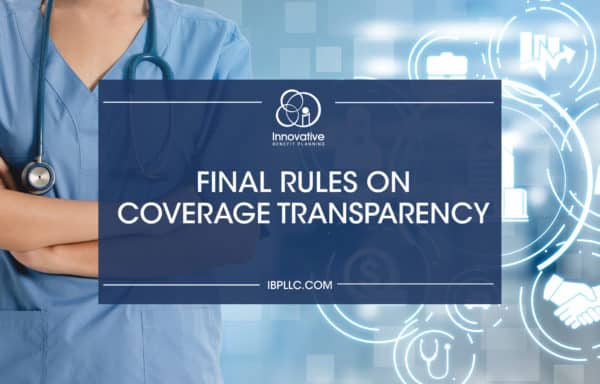Final Rules on Coverage Transparency

Final Rules on Coverage Transparency
On October 29, 2020, the Internal Revenue Service (IRS), Department of Labor (DOL), and the Department of Health and Human Services (HHS) (collectively, Departments), released final rules on coverage transparency, in order to provide health coverage recipients with an estimate of their potential cost-sharing liability for health related services prior to the receipt of care. The final rules require group health plans and insurance issuers in the individual and group markets to disclose cost-sharing information and negotiated rates in electronic or paper form. The final rules also allow issuers to reward plan enrollees with “shared savings payments,” without running afoul of medical loss ratio (MLR) requirements. Issuers are permitted to provide employees who use lower-priced providers with a percentage of the savings relative to a benchmark.
Effective Dates
- Public Disclosure of Negotiated Rates and Historical Allowed Amounts: January 1, 2022
- Disclosure of Cost Information: January 1, 2023, through January 1, 2024 (three-year phase-in)
- Medical Loss Ratio Calculation: 2020 MLR Reporting Year
Highlights
Disclosure Obligation
A plan or issuer must disclose information regarding a covered item or service upon request, including: 1) estimated cost-sharing liability; 2) the amount of financial responsibility that a participant, beneficiary, or enrollee has incurred at the time the request for cost-sharing information is made, with respect to a deductible and/or an out-of-pocket limit; 3) in-network rates; 4) out of network rates; 5) items and services content list; and 6) notice informing the individual that a specific covered item or service for which the individual requests cost-sharing information may be subject to a prerequisite for coverage, with disclaimers regarding out-of-network charges, actual charges, and estimated cost sharing liability.
Electronic Disclosure
Electronic disclosure must be made via an internet based self-service tool which allows the user to search for real-time cost-sharing information provided by a specific in-network provider, or by all in-network providers. The tool must also allow users to search for the out-of-network allowed amounts. The tool must allow the user to refine and reorder search results based on geographic proximity of in-network providers. Plans and issuers are encouraged to rely upon federal plain language guidelines and ERISA disclosure requirements for presentation, and general industry standards for guidance on developing internet-based self-service tools. The tool must be accessible via website.
Paper Disclosure
Upon request by the participant, beneficiary, or enrollee, the cost-sharing information described above must be disclosed in paper form. Similar to the requirements for the internet-based self-service tool, the plan or issuer must allow an individual to request cost-sharing information for a discrete covered item or service by billing code or descriptive term. The information must be mailed to the requesting participant, beneficiary, or enrollee no later than two business days after the request is received. A plan or issuer may limit any results for a paper request to 20 providers per request.
Public Disclosure
Group health plans and health insurance issuers must disclose to the public, through three machine-readable files: 1) the negotiated rates for in-network providers for all covered items and services; 2) unique amounts a plan or issuer allowed for all covered items or services, including prescription drugs, furnished by out-of-network providers during a specified time period; and 3) prescription drug pricing information for in-network providers. The files must be available on a website and must be accessible free of charge, without requiring the user to establish an account, password, or other credentials, and without having to submit any personal identifying information such as a name or email address.
Good Faith Safe Harbor
A plan or issuer will not fail to comply with the final rules, if acting in good faith and with reasonable diligence and errors and omissions are corrected as soon as possible. To the extent such error or omission is due to good faith reliance on information from another entity, the final rules include a special applicability provision that holds the plan or issuer harmless, unless the plan or issuer knows, or reasonably should have known, that the information is incomplete or inaccurate.
Shared Savings and the MLR Rule
Shared savings may be factored into an issuer’s MLR calculation beginning with the 2020 MLR reporting year. If a plan is designed to incentivize consumers to shop for services from lower cost, higher-value providers and the design results in savings, issuers can take credit for the “shared savings” payments made to participants in the numerator of the MLR calculation. Issuers are not required to pay MLR rebates based on a plan design that provides a benefit to consumers that is not currently captured in any existing MLR revenue or expense category.
Innovative is working with the insurance carriers and TPA’s to further evaluate the best course of action and options for our clients. If you have any questions regarding the final rules on coverage transparency, please contact Innovative Benefit Planning at icomply@ibpllc.com
For a downloadable compliance bulletin, click here.
Categories
Archive








